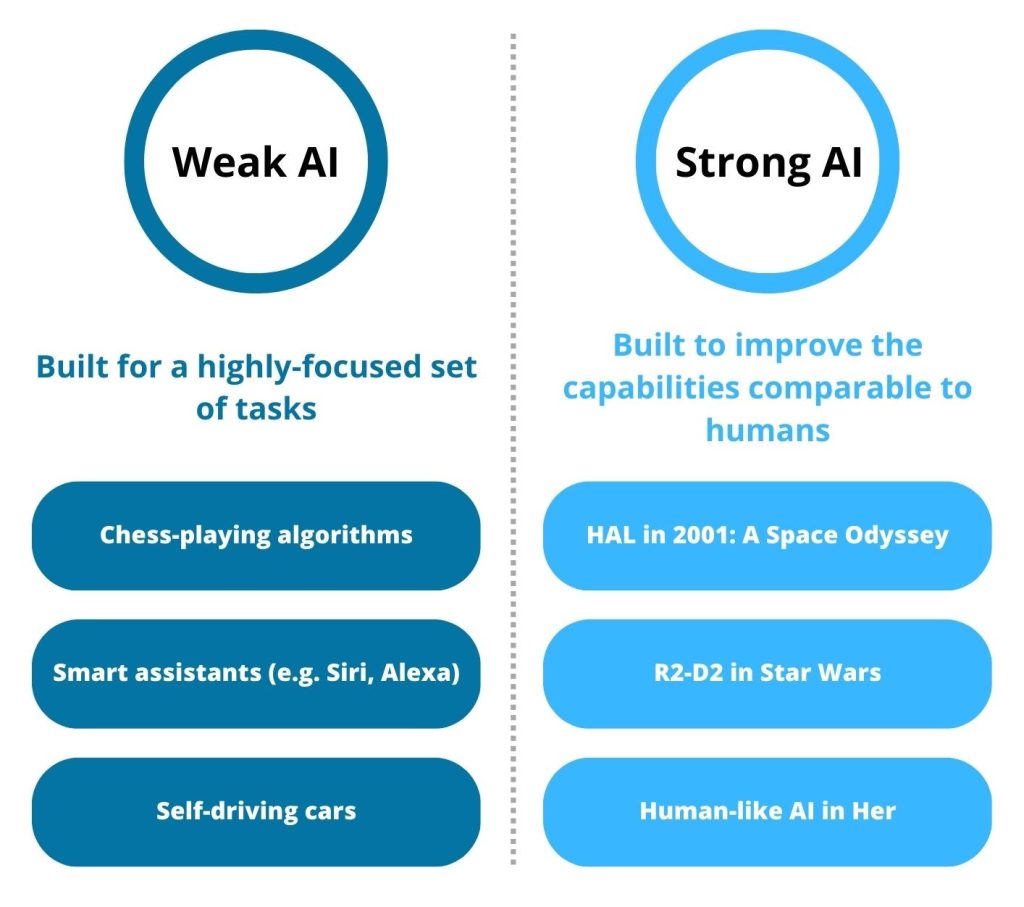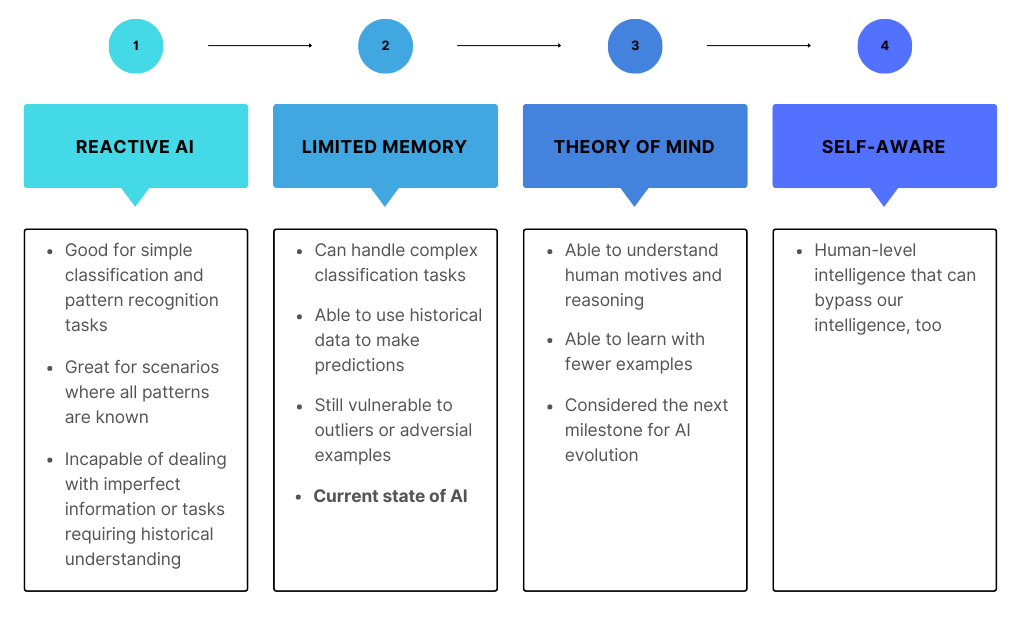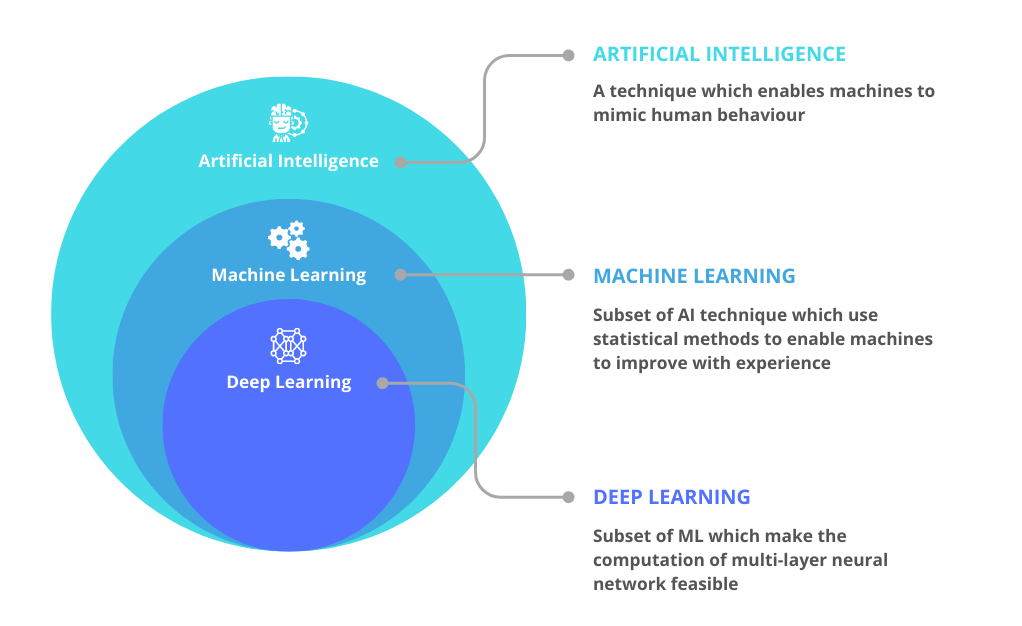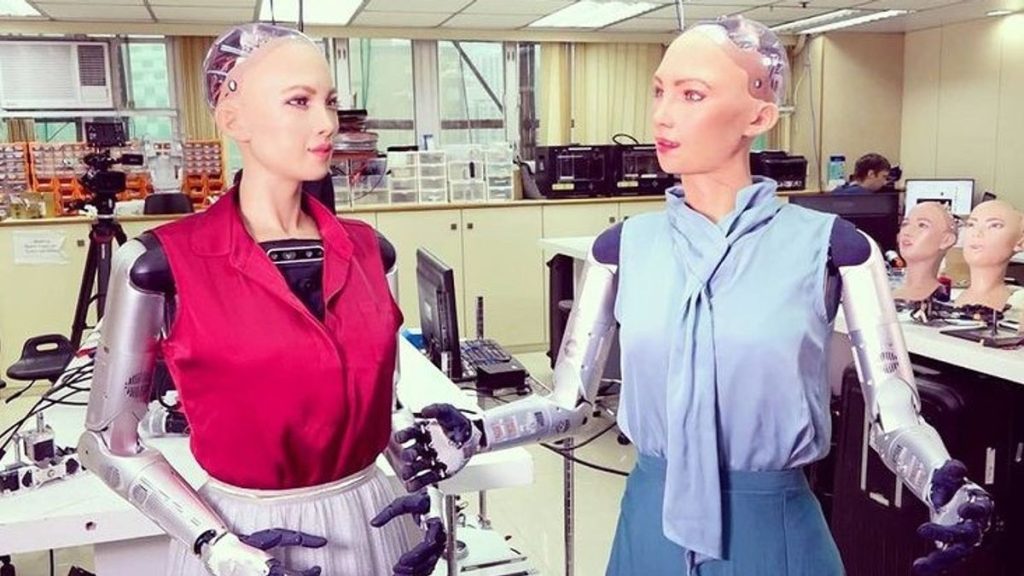Artificial intelligence (AI) has become an incredibly popular and widely discussed topic in the tech industry, and for good reason. In recent years, we've witnessed incredible breakthroughs and advancements that were once only imaginable in science fiction slowly becoming a reality.
Experts recognize AI as a significant factor in driving productivity. It has the potential to unlock new sources of growth and revolutionize how work is conducted across various industries. According to a PWC article, AI has the power to contribute a staggering $15.7 trillion to the global economy by 2035. The upcoming AI boom is expected to benefit countries like China and the United States the most, accounting for nearly 70% of its worldwide impact.

If you're looking to gain a better understanding of AI, its inner workings, its advantages and disadvantages, its diverse applications, certifications, and the reasons why mastering this field is valuable, the Intersog tutorial provides a comprehensive overview. It covers all these aspects and can serve as a valuable resource for anyone interested in exploring AI further.
Here’s the list of contents to help you navigate throughout our tutorial:
- What Is Artificial Intelligence?
- A brief history of Artificial Intelligence
- Weak AI vs. Strong AI
- Types of Artificial Intelligence
- How does Artificial Intelligence work?
- AI programming cognitive skills
- Subcategories of AI
- Applications of Artificial Intelligence
- Artificial Intelligence examples
- Who does an Artificial Intelligence team consist of?
What Is Artificial Intelligence?
Artificial Intelligence (AI) refers to a field of computer science that aims to enable computers, computer-controlled robots, and software to exhibit intelligent behavior similar to that of the human mind. The core principle of AI involves studying the patterns and processes of human cognition and using that knowledge to create intelligent software and systems.
Through extensive research and analysis of the human brain, AI seeks to understand how humans perceive, learn, and make decisions. By uncovering these cognitive processes, AI developers can design algorithms and models that simulate intelligent thinking and problem-solving.
The ultimate goal of AI is to develop systems that can reason, learn from experience, adapt to new situations, and perform tasks that typically require human intelligence.
By harnessing the power of AI, we can create software and machines that can perform complex tasks, automate processes, provide personalized recommendations, and assist in various industries such as healthcare, finance, transportation, and entertainment.
In summary, AI aims to replicate human intelligence in computer systems, allowing them to think, learn, and make decisions in ways that mimic human capabilities.
Check out a related article:
AI's Powerful Duo: Difference Between Machine Learning and Deep Learning
A brief history of Artificial Intelligence
Artificial Intelligence (AI) has a rich history that spans several decades. Here's a brief overview of the key milestones and developments in the field:

1950s: The birth of AI can be traced back to the 1950s when researchers began exploring the concept of creating machines that could exhibit intelligent behavior. Pioneering figures like Alan Turing proposed the idea of machine intelligence and developed the famous "Turing Test" to assess a machine's ability to exhibit human-like intelligence.
1956: The term "artificial intelligence" was coined by John McCarthy, who organized the Dartmouth Conference, considered the official birth of AI as an academic discipline. The conference brought together leading scientists to explore the possibilities and potential of AI.
1960s-1970s: During this period, AI researchers focused on developing expert systems, which were computer programs designed to mimic the decision-making capabilities of human experts in specific domains. However, early AI systems faced limitations due to hardware constraints and the complexity of real-world problems.
1980s-1990s: AI experienced a period of "AI winter" characterized by reduced funding and public interest. Progress in AI research slowed down, and expectations for AI were not met. However, research continued in areas such as machine learning, knowledge representation, and natural language processing, laying the foundation for future advancements.

Late 1990s-early 2000s: AI witnessed a resurgence as computational power increased, and new techniques like neural networks and data-driven approaches gained traction. Applications like speech recognition, computer vision, and data mining started to deliver promising results.
2010s: The 2010s marked significant breakthroughs in AI, driven by advancements in deep learning and big data. Deep learning models, powered by neural networks with many layers, demonstrated remarkable performance in various tasks such as image recognition, natural language processing, and game playing.
Present day: AI is now an integral part of our lives, with applications ranging from virtual assistants and recommendation systems to autonomous vehicles and healthcare diagnostics. Machine learning, deep learning, and reinforcement learning techniques continue to evolve, pushing the boundaries of what AI can achieve.
Weak AI vs. Strong AI
The distinction between Weak AI and Strong AI lies in their capabilities and level of human-like intelligence:
Weak AI, also known as Narrow AI or Applied AI, refers to AI systems designed to perform specific tasks or functions within a limited domain. Weak AI is focused on solving specific problems and lacks general intelligence. These systems are trained or programmed to excel in specific areas, such as speech recognition, image classification, or playing chess. They operate within well-defined boundaries and cannot extend their knowledge or skills beyond their specific domain.
Strong AI, also referred to as Artificial General Intelligence (AGI) or Human-Level AI, aims to replicate human-level intelligence across a broad range of tasks and domains. Strong AI systems possess the ability to understand, learn, and apply knowledge in a manner that reflects human-like cognitive capabilities. They can exhibit consciousness, self-awareness, and reasoning abilities that are comparable to human intelligence. Strong AI seeks to mimic the complexity and adaptability of the human mind, enabling machines to exhibit a wide range of cognitive functions and perform tasks across diverse domains.
In summary, Weak AI focuses on specific tasks and operates within well-defined limitations, while Strong AI aims to create machines that possess general intelligence, capable of reasoning, learning, and adapting across various domains. While Weak AI is prevalent in today's applications, Strong AI remains an ongoing area of research and development, striving to achieve a level of intelligence that closely resembles human cognition.

Types of Artificial Intelligence
Artificial Intelligence (AI) encompasses various types, each with its own distinct characteristics. Let's delve into the different categories:
- Purely Reactive AI: These AI machines operate solely in the present moment, lacking memory or the ability to store past data. They excel in specific tasks and make decisions based on real-time observations. For instance, in a chess game, a purely reactive AI analyzes the current board state and determines the optimal move without considering past games.
- Limited Memory AI: Unlike purely reactive AI, these machines have the capability to retain and utilize past data. While their memory capacity is limited, they can make more informed decisions by incorporating historical information. For example, a limited memory AI system can recommend a restaurant based on the user's location and previous dining preferences stored in its memory.
- Theory of Mind AI: This type of AI is hypothetical and still in the realm of ongoing research. Theory of Mind AI aims to develop machines that can understand and interpret human thoughts, emotions, and social interactions. Although not yet realized, such AI systems would possess a level of cognitive understanding and social awareness.
- Self-Aware AI: Considered the future generation of AI, self-aware machines would exhibit intelligence, sentience, and consciousness. While the development of fully self-aware AI remains speculative and futuristic, it represents the concept of AI systems achieving a level of awareness akin to human consciousness.
These different types of AI highlight the evolving nature of artificial intelligence, with each category showcasing unique characteristics and levels of sophistication. From reactive systems focused on immediate tasks to potential future developments in understanding human cognition and achieving self-awareness, AI continues to progress in remarkable ways.

How does Artificial Intelligence work?
Artificial Intelligence (AI) operates through a combination of data, algorithms, and computing power. The underlying process can be summarized in the following steps:
- Data Collection: AI systems rely on vast amounts of data to learn and make informed decisions. This data can be obtained from various sources, such as sensors, databases, or the internet.
- Data Preprocessing: Before AI algorithms can analyze the data, it often needs to be cleaned, organized, and prepared for further processing. This step involves removing noise, handling missing values, and transforming the data into a suitable format.
- Algorithm Selection: Different AI algorithms are designed to solve specific problems. The choice of algorithm depends on the nature of the task, such as classification, regression, clustering, or natural language processing. Each algorithm has its own set of rules and mathematical calculations to extract patterns and insights from the data.
- Model Training: AI models need to be trained on labeled data, where the desired output is known. During training, the algorithm adjusts its internal parameters to minimize the difference between predicted outputs and the actual outcomes. This iterative process allows the model to learn patterns and generalize from the training data.
- Evaluation and Optimization: After training, the AI model is evaluated on a separate dataset to assess its performance. Metrics like accuracy, precision, recall, or F1 score are used to measure the model's effectiveness. If necessary, the model's parameters and architecture can be fine-tuned to enhance its performance.
- Deployment and Inference: Once the AI model is deemed satisfactory, it can be deployed to make predictions or decisions on new, unseen data. This stage is known as inference, where the model applies its learned knowledge to new inputs and generates outputs.
- Continuous Learning and Improvement: AI systems can incorporate feedback loops to continually update and improve their performance. New data can be fed back into the system to retrain the model or fine-tune its parameters, ensuring that the AI system adapts to changing conditions and remains accurate over time.
It's important to note that the specifics of how AI works can vary depending on the algorithm, domain, and application. The above steps provide a general overview of the underlying principles and processes involved in AI.
Check out a related article:
The Future is Now: Key AI Development Trends for 2023
AI programming cognitive skills
AI programming cognitive skills, namely learning, reasoning, and self-correction, are fundamental aspects of artificial intelligence systems that enable them to perform tasks and make decisions. Let's explore each skill in more detail:
- Learning: Learning is a crucial cognitive skill in AI programming. It involves the ability of AI systems to acquire knowledge, identify patterns, and improve their performance based on experience or data. There are different types of learning approaches used in AI:
- Supervised Learning: In this approach, AI models are trained on labeled data, where the desired output is provided. The model learns to map inputs to outputs by minimizing the error between predicted and actual outcomes.
- Unsupervised Learning: In unsupervised learning, AI models learn from unlabeled data without any predefined outputs. The objective is to discover underlying patterns, relationships, or structures in the data.
- Reinforcement Learning: Reinforcement learning involves training AI agents through trial and error. The agent interacts with an environment and receives feedback in the form of rewards or penalties, allowing it to learn optimal actions and strategies to maximize rewards.
- Reasoning: Reasoning refers to the ability of AI systems to draw logical conclusions, make inferences, and perform logical operations based on the available information. It involves the use of rules, logical frameworks, and knowledge representation to derive new knowledge or solve problems. Reasoning enables AI systems to think logically and make rational decisions.
- Deductive Reasoning: Deductive reasoning starts with general rules or premises and derives specific conclusions. It follows a top-down approach, where the conclusions are guaranteed to be true if the initial premises are true.
- Inductive Reasoning: Inductive reasoning involves making generalizations or predictions based on specific observations or patterns. It follows a bottom-up approach, where the conclusions are likely to be true based on the available evidence.
- Self-Correction: Self-correction is the ability of AI systems to recognize and correct errors or inaccuracies in their output. It involves monitoring the system's performance, detecting deviations or mistakes, and making adjustments to improve accuracy and reliability. Self-correction mechanisms are essential for ensuring the ongoing optimization and refinement of AI systems.
Subcategories of AI
Artificial Intelligence Solutions (AI) can be categorized into several subfields or subcategories, each focusing on different aspects of AI research and application. Here are some notable subcategories of AI:
- Machine Learning: Machine learning is a subcategory of AI that focuses on developing algorithms and models that enable machines to learn from data and improve their performance without explicit programming. It includes techniques such as supervised learning, unsupervised learning, reinforcement learning, and deep learning.
- Deep Learning: Deep learning is a specific subset of machine learning that uses artificial neural networks to simulate the human brain's structure and function. It involves training deep neural networks with multiple layers to extract hierarchical representations from data, enabling the machine to learn complex patterns and make accurate predictions.

It’s worth noting that differences and working principles ML and DL are a subject worth another article. We promice to deliver it as soon as possible.
- Natural Language Processing (NLP): Techniques for understanding and generating human language, including text analysis and chatbots.
- Computer Vision: Giving machines the ability to "see" and understand visual information from images or videos.
- Robotics: Intelligent machines that can perceive the environment, make decisions, and perform physical tasks.
- Expert Systems: Programs that mimic human expert decision-making in specific domains using knowledge bases and inference engines.
- Knowledge Representation and Reasoning: This subcategory focuses on representing knowledge in a structured manner and building reasoning mechanisms to derive new knowledge or make inferences.
- Cognitive Computing: Integrating AI technologies to mimic human cognitive processes like pattern recognition and decision-making.
Applications of Artificial Intelligence
Artificial Intelligence (AI) has a wide range of applications across various industries and sectors. Here are some notable areas where AI is being employed:

Healthcare: AI is revolutionizing healthcare by assisting in disease diagnosis, drug discovery, and personalized treatment plans. It enables the analysis of medical images, such as X-rays and MRIs, for accurate diagnoses. AI-powered systems can also monitor patient data in real-time, predict disease progression, and aid in identifying potential health risks.

Finance and Banking: AI is used in fraud detection, risk assessment, algorithmic trading, and customer service in the financial sector. AI-powered chatbots and virtual assistants enhance customer interactions, while machine learning algorithms analyze financial data for pattern recognition and fraud prevention.

Transportation: AI plays a significant role in autonomous vehicles, optimizing transportation routes, and improving traffic management systems. Self-driving cars rely on AI algorithms for navigation and decision-making, enhancing safety and efficiency. AI is also used in logistics and supply chain management for optimizing operations and reducing costs.

E-commerce and Retail: AI is utilized in personalized product recommendations, customer behavior analysis, and demand forecasting. AI-powered chatbots assist customers in finding products and provide support. Computer vision technology enables visual search and object recognition, enhancing the online shopping experience.

Manufacturing and Robotics: AI-driven robotics and automation enhance manufacturing processes, improving efficiency, precision, and productivity. Robots equipped with AI capabilities can perform complex tasks, handle quality control, and operate in hazardous environments.

Smart Homes and Internet of Things (IoT): AI enhances the functionality of smart home devices, enabling voice-controlled assistants, smart thermostats, automated lighting, and security systems. AI algorithms analyze IoT data to optimize energy consumption and improve home automation.

Customer Service: AI-powered chatbots and virtual assistants are increasingly used in customer service to provide real-time support, answer inquiries, and handle routine tasks. These AI systems can understand natural language, learn from interactions, and provide personalized assistance.
These are just a few examples, as AI is being applied in numerous other fields such as education, agriculture, entertainment, cybersecurity, and more. The versatility of AI allows it to transform various industries, streamline processes, and deliver innovative solutions to complex problems.
Check out a related article:
The Match Made in Heaven: 9 Examples of Using AI in FinTech
Examples of Artificial Intelligence applications
Artificial Intelligence (AI) has permeated numerous aspects of our daily lives, revolutionizing industries and enhancing user experiences. Here are notable examples showcasing the breadth of AI applications:
1. ChatGPT: OpenAI's advanced language model, ChatGPT, engages in natural language conversations, making it valuable for virtual assistants, chatbots, and customer support services. It generates human-like responses using deep learning techniques.
2. Google Maps: By leveraging AI algorithms, Google Maps offers real-time navigation, traffic updates, and personalized recommendations. It analyzes extensive data, including historical traffic patterns and user input, to suggest optimal routes and predict congestion.
3. Smart Assistants: AI-driven smart assistants like Amazon's Alexa, Apple's Siri, and Google Assistant interpret voice commands, provide information, and perform tasks. Natural language processing and machine learning enable these assistants to understand user intent and deliver relevant responses.
4. Tesla Autopilot: Tesla's Autopilot system utilizes AI and advanced sensors to enable semi-autonomous driving capabilities in Tesla vehicles. It can assist with tasks like steering, lane changing, and adaptive cruise control.

5. Google Translate and DeepL: These products utilize AI technologies, including machine learning and neural networks, to provide real-time language translation services across multiple languages.
6. Netflix Recommendation System: Netflix uses AI algorithms to analyze user preferences and viewing habits to provide personalized recommendations for movies and TV shows.
7. IBM Watson for Oncology: IBM Watson's AI capabilities are applied in healthcare to assist oncologists in cancer treatment decision-making. It analyzes patient data and medical literature to provide personalized treatment recommendations.
8. DeepMind's AlphaGo: AlphaGo, developed by DeepMind (a subsidiary of Google), is an AI program that achieved remarkable success in playing the board game Go. It defeated world champion Go player Lee Sedol, showcasing the capabilities of AI in complex strategy games.
9. Sophia the Robot: Sophia, developed by Hanson Robotics, is a humanoid robot known for its human-like appearance and AI capabilities. It can engage in conversations, recognize faces, and display emotions, contributing to advancements in social robotics.

And a few examples from Intersog:
Deana.AI: A virtual assistant that turns your emails into a convenient productivity tool. A text-based artificial intelligence reads and executes text commands using GTP-3 and a custom NLP model.
FIDO: A FinTech company reshaping the way financial services are accessed and provided in developing countries of Africa and Pacific Asia via AI and big data.
Neustar: A world-famous information services vendor formed on the foundation of Privacy by Design. By utilizing its unique, precise, and real-time identity system, Neustar helps its clients grow and promote their businesses with the deepest understanding of how to connect people, places, and things.
Who does an Artificial Intelligence team consist of?
It's important to note that the specific composition and roles within an AI team may vary depending on the organization, project scope, and requirements. Here are some key members commonly found in an AI software development team:
- Data Scientists: Data scientists are responsible for analyzing and interpreting large volumes of data, designing AI models and algorithms, and developing machine learning solutions. They have expertise in statistics, mathematics, and programming.
- Machine Learning Engineers: Machine learning engineers specialize in designing and implementing machine learning systems and algorithms. They work closely with data scientists to translate models into practical applications and optimize them for deployment.
- Software Engineers: Software engineers play a crucial role in developing the infrastructure and software components required for AI systems. They build the software architecture, integrate AI models into existing systems, and ensure scalability and performance.
- AI Researchers: AI researchers focus on advancing the field of artificial intelligence through innovative research. They explore new algorithms, techniques, and methodologies to solve complex problems and push the boundaries of AI capabilities.
- Domain Experts: Domain experts possess in-depth knowledge and expertise in specific industries or fields. They provide insights and guide the development of AI solutions tailored to meet industry-specific challenges and requirements.
- Project Managers: Project managers oversee the planning, execution, and delivery of AI projects. They ensure coordination among team members, manage timelines, and communicate with stakeholders to ensure project success.
- Data Engineers: Data engineers are responsible for building and maintaining the infrastructure required to collect, store, and process large datasets. They develop data pipelines, ensure data quality, and support data integration for AI applications.
- UX/UI Designers: User experience (UX) and user interface (UI) designers focus on creating intuitive and user-friendly interfaces for AI applications. They work closely with the team to design visually appealing and interactive experiences that enhance user engagement.
If you are in need of AI specialists, look no further than Intersog. We are proud to offer a team of highly skilled and experienced AI professionals who can meet your specific requirements. Whether you require expertise in machine learning, natural language processing, computer vision, or other AI domains, our specialists are ready to provide innovative artificial intelligence software solutions tailored to your business needs. Feel free to contact us for a free quote or consultation.
Leave a Comment